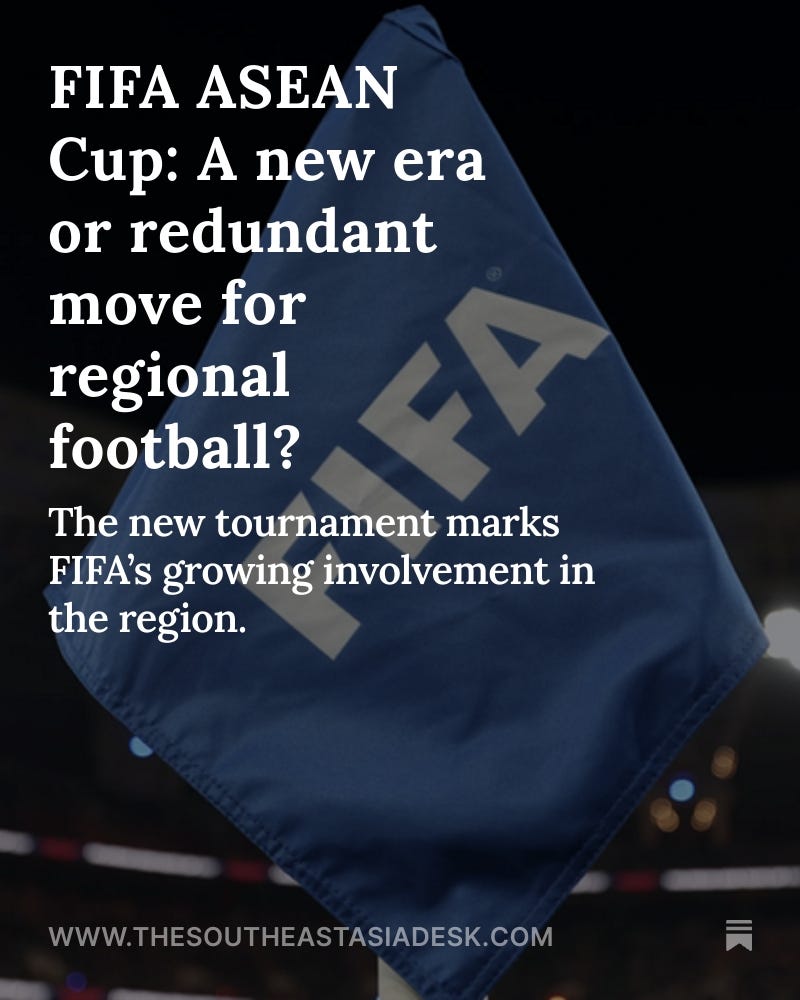Hello and welcome to The Southeast Asia Desk Weekly — I’m Akasha Viandri, and this is where we slow down the headlines and make sense of the stories shaping our region.
Today, we’re talking about football — and not just any football.
Because when FIFA and ASEAN start talking about co-hosting a FIFA–ASEAN Cup, you know something bigger is at play than just goals and glory.
🎣 The Hook
Imagine this: It’s 2034. The stadium lights in Bangkok flicker to life. Kuala Lumpur’s Bukit Jalil roars with fans. And Jakarta’s GBK shakes like a drum.
The dream? Southeast Asia, united — hosting the world.
That’s the image leaders have been selling. But here’s the question:
Is the FIFA–ASEAN Cup really a new era for regional unity… or just a redundant sequel no one asked for?
🧭 The Story
Let’s rewind.
ASEAN first floated the dream of hosting a World Cup as a bloc more than a decade ago.
It was ambitious — maybe too ambitious.
Ten countries, multiple currencies, and wildly different infrastructure standards.
FIFA smiled politely — and moved on.
Fast-forward to 2025, and the conversation is back — but with a twist.
This time, it’s not about the World Cup itself, but a FIFA-sanctioned regional tournament:
The FIFA–ASEAN Cup — a kind of “Asia’s Euro,” they say.
Sounds good on paper.
It could boost tourism, infrastructure, and yes, ASEAN’s image as a cohesive sporting region.
But skeptics point out… we already have something called the *AFF Cup* — run by the ASEAN Football Federation — and it’s beloved.
So… what’s the point of adding another layer?
⚽ The Politics Behind the Pitch
This is where the story gets interesting.
Because this isn’t just about football — it’s about soft power.
FIFA wants to expand its influence in emerging markets.
And ASEAN governments? They love the optics of unity — especially when the world is watching.
For Indonesia, Thailand, Vietnam, and Malaysia — co-hosting a FIFA event means legitimacy, global branding, and diplomatic capital.
But for smaller members — like Laos, Cambodia, or Brunei — the benefits are less clear.
It could deepen the gap between “big football” and the rest.
And let’s be honest — mega-events have a history.
They bring short-term buzz, but also long-term bills.
Ask Brazil. Ask South Africa. Ask Qatar.
💭 So What Does It Really Mean?
Maybe the FIFA–ASEAN Cup isn’t about finding the best football.
Maybe it’s about testing ASEAN’s ability to act as one — to prove that “One Vision, One Identity, One Community” isn’t just a slogan.
But if it becomes another top-down initiative — led by politicians, not players —
then it risks becoming just another acronym in ASEAN’s long alphabet soup.
Still, it’s hard not to feel a bit of hope.
Because if there’s one thing that unites Southeast Asia — it’s football.
Not policy, not summits, not communiqués — but the sound of a stadium erupting in collective joy.
📩 The Wrap
So, as FIFA and ASEAN hammer out the details, maybe the real question isn’t if this cup will happen — but whether it will matter.
I’m Akasha Viandri, and this has been The Southeast Asia Desk Weekly — where we slow down the noise, and follow the region’s compass.
If you enjoyed this episode, subscribe to our newsletter at thesoutheastasiadesk.com and join us again next weekend, for stories to linger over, one weekend at a time.
(AKS/QOB)











